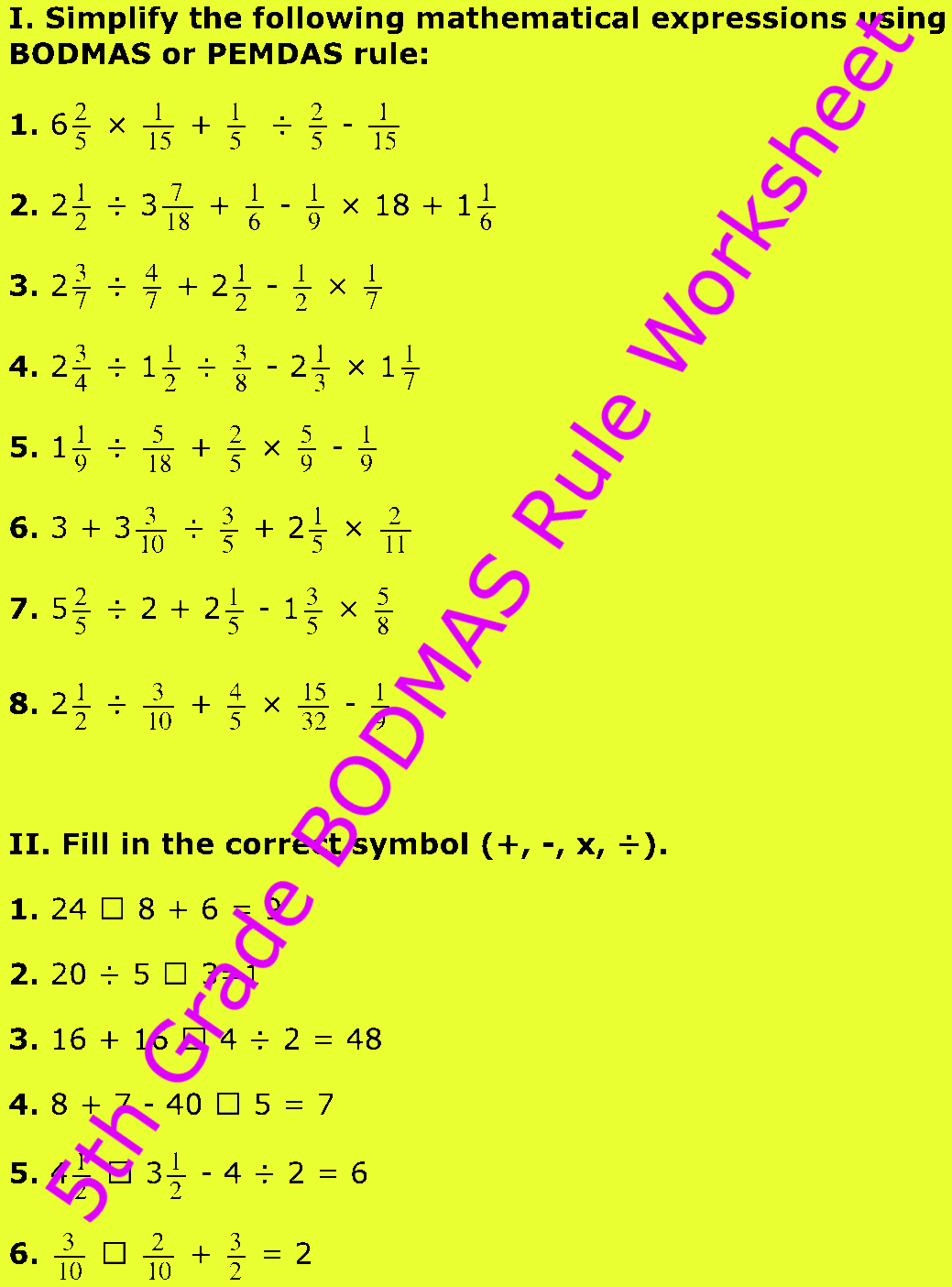Subscribe to our ▶️ YouTube channel 🔴 for the latest videos, updates, and tips.
5th Grade BODMAS Rule Worksheet
In 5th Grade BODMAS Rule Worksheet you will get different types of problems on mathematical expressions involving different operations, mathematical expression with 'brackets' and 'of' and simplifying mathematical expressions in a certain order of operations.
I. Simplify the following mathematical expressions using BODMAS or PEMDAS rule:
1. 6\(\frac{2}{5}\) × \(\frac{1}{15}\) + \(\frac{1}{5}\) ÷ \(\frac{2}{5}\) - \(\frac{1}{15}\)
2. 2\(\frac{1}{2}\) ÷ 3\(\frac{7}{18}\) + \(\frac{1}{6}\) - \(\frac{1}{9}\) × 18 + 1\(\frac{1}{6}\)
3. 2\(\frac{3}{7}\) ÷ \(\frac{4}{7}\) + 2\(\frac{1}{2}\) - \(\frac{1}{2}\) × \(\frac{1}{7}\)
4. 2\(\frac{3}{4}\) ÷ 1\(\frac{1}{2}\) ÷ \(\frac{3}{8}\) - 2\(\frac{1}{3}\) × 1\(\frac{1}{7}\)
5. 1\(\frac{1}{9}\) ÷ \(\frac{5}{18}\) + \(\frac{2}{5}\) × \(\frac{5}{9}\) - \(\frac{1}{9}\)
6. 3 + 3\(\frac{3}{10}\) ÷ \(\frac{3}{5}\) + 2\(\frac{1}{5}\) × \(\frac{2}{11}\)
7. 5\(\frac{2}{5}\) ÷ 2 + 2\(\frac{1}{5}\) - 1\(\frac{3}{5}\) × \(\frac{5}{8}\)
8. 2\(\frac{1}{2}\) ÷ \(\frac{3}{10}\) + \(\frac{4}{5}\) × \(\frac{15}{32}\) - \(\frac{1}{9}\)
II. Fill in the correct symbol (+, -, x, ÷).
1. 24 ⟎ 8 + 6 = 9
2. 20 ÷ 5 ⟎ 3=1
3. 16 + 16 ⟎ 4 ÷ 2 = 48
4. 8 + 7 - 40 ⟎ 5 = 7
5. 4\(\frac{1}{2}\) ⟎ 3\(\frac{1}{2}\) - 4 ÷ 2 = 6
6. \(\frac{3}{10}\) ⟎ \(\frac{2}{10}\) + \(\frac{3}{2}\) = 2
III. Simplify the following order of operations using BODMAS rule:
1. (2\(\frac{1}{4}\) + 3\(\frac{2}{5}\)) ÷ (1\(\frac{1}{3}\) + 1\(\frac{1}{6}\)) × 2\(\frac{1}{4}\)
2. 15 ÷ [2\(\frac{1}{2}\) + {2 (2 + \(\overline{1\frac{1}{3} - \frac{1}{2}}\))}]
3. 2\(\frac{1}{2}\) + {4 (5 + \(\overline{6 - 4}\))}
4. 12 + [4 - {1 + (4 × \(\frac{3}{8}\))}]
5. 2\(\frac{1}{2}\) [9\(\frac{1}{2}\) - (19\(\frac{1}{2}\) - \(\overline{7\frac{1}{5} × 1\frac{1}{2}}\))}
6. 8\(\frac{7}{8}\) - (1\(\frac{1}{5}\) - \(\overline{\frac{1}{2} - \frac{1}{4}}\)) of 8
7. 9 + [\(\frac{1}{2}\) of {6 - 2 (9 - \(\overline{6 - 3}\))}]
8. \(\frac{1}{7}\) of [5 + {3 (9 + \(\overline{3 - 2}\))}] - 3
9. 24 + [4 - {3 + (6 × \(\frac{1}{18}\))}] ÷ \(\frac{2}{3}\)
10. (14\(\frac{1}{4}\) - 1\(\frac{3}{5}\)) × (\(\frac{1}{16}\) of 3\(\frac{1}{5}\)) ÷ 1\(\frac{4}{9}\)
11. (2\(\frac{3}{4}\) - \(\frac{1}{4}\)) ÷ 1\(\frac{4}{9}\) - (\(\frac{1}{3}\) × \(\frac{3}{8}\)) ÷ \(\frac{1}{8}\) + 2
12. (21\(\frac{1}{7}\) - 2\(\frac{2}{9}\)) × (\(\frac{4}{9}\) of 4 × \(\frac{3}{8}\)) ÷ 1\(\frac{1}{9}\)
5th Grade BODMAS Rule Worksheet Answer
I. 1. \(\frac{43}{50}\)
2. \(\frac{13}{183}\)
3. 6\(\frac{19}{28}\)
4. 2\(\frac{2}{9}\)
5. 4\(\frac{1}{9}\)
6. 8\(\frac{9}{10}\)
7. 3\(\frac{9}{10}\)
8. 8\(\frac{43}{72}\)
II. 1. ÷
2. -
3. ×
4. ÷
5. +
6. +
III. 1. 5\(\frac{17}{200}\)
2. 1\(\frac{41}{49}\)
3. 30\(\frac{1}{2}\)
4. 13\(\frac{1}{2}\)
5. 2
6. 1\(\frac{11}{40}\)
7. 12
8. 2
9. 25
10. 1\(\frac{977}{1300}\)
11. 2\(\frac{19}{26}\)
12. 11\(\frac{37}{105}\)
From Rules to Add Integers to HOME PAGE
Didn't find what you were looking for? Or want to know more information about Math Only Math. Use this Google Search to find what you need.



New! Comments
Have your say about what you just read! Leave me a comment in the box below. Ask a Question or Answer a Question.